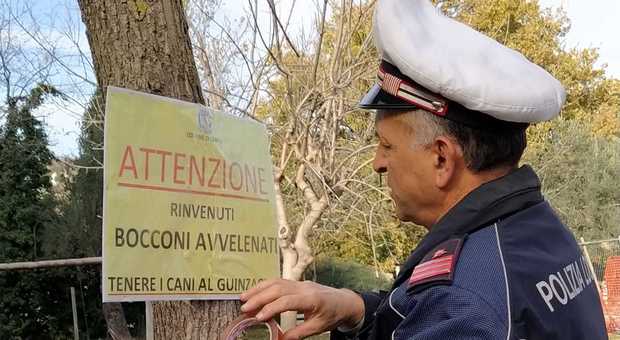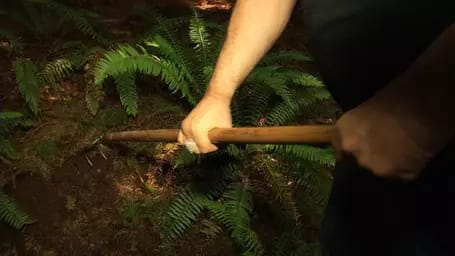A lot has been written about the darker aspects of truffle hunting in the last few years. Stories about dog-poisoning, GBH and arson attacks make for interesting reading at the best of times. All the more so when the incidents offer an insight into a very secretive circle that few have access to. Thankfully these dramatic episodes are hardly a representative insight into the fungus hunters\ world. The majority of truffling goes off with little more sensational than a pair of ripped trousers or a sandwich getting stolen by one of the dogs.

Occasionally though, the tedium is broken by events such as the one in Manoppello, Abruzzo in December 2020. Carabinieri from the forestry unit of Pescara arrested a hunter they had under surveillance. This overly keen person had placed a homemade incendary device under the vehicle of a rival – a man whose dog the would-be bomber had previously seen off with a rat-poison laced bratwurst.
It could be argued that this kind of episode is not especially newsworthy. After all it is not only in truffling that rivalry exists – all professions harbour people of meagre scruples ready to employ underhand tactics in order to protect their livelihood. Aside from the money to be made from truffling there is an intrinsic competitiveness to be found in most forms of hunting. Many good hunters have a competitive spirit but if their determination is part of a more aggressive nature – the kind of character that must win at all costs, then a pleasant activity can quickly turn sour. Similarly, personalities that all to readily fall foul of the destructive grips of jealousy or the smart of a bruised ego need to check themselves.
There are scant labour laws to protect trufflers when they have been wronged, so disputes which do turn nasty are generally sorted out there and then in the field. Those who are involved in truffling would do well to be aware of the codes of behaviour that most truffle hunters respect . This code is generally unspoken. Perhaps it shouldn’t be – there are some secrets which cause less damage when revealed. Following the code or at least knowing of its existence could help to limit the unpleasant incidents.
The thing is, most of these incidents do not occur without context and it is usually this context that the reporter is ignorant of. The above mentioned article concludes by speculating that the dog-poisoner of Abruzzo ‘may have done everything to dissuade other truffle hunters from frequenting the area, to keep away the competition.’ And perhaps this is true and the victim was entirely blameless in this particular matter. It often happens that the perpetrator is simply a bad egg who wants control of the ground.
Territory battles go with the territory. There are some growing areas that are hidden away, essentially private spots where you get to hunt undisturbed. Hunters can frequent a site like this for years and feel a personal attachment to it. It will then be frustrating when you arrive one morning to find that someone else has discovered your favourite patch and has removed all the truffles. This is part of the job and is something a hunter has to put up with. As our parents were always telling us – you have to learn to share. There is another type of truffle site which is more obvious and easily-located. The area will be well known by the hunters of the region. Although these growing areas are accessible to all members of the public, certain characters can feel as though the place belongs to them or, at the very least, to the local hunters. Outsiders are not welcome and the home team will behave accordingly to protect their interests. Matters get out of hand and an innocent dog pays the price. To lose a hard-working companion, the beloved family pet in such a way is heart-breaking.
There are no excuses whatsover for this kind of behaviour but in many cases the unsavoury story is part of a narrative more complex than run-of-the-mill territorial rivalry. In the past these disputes would have been sorted out locally. Now they attract the attention of journalists most of whom know little about how truffling works. This means that the context or the background to these stories is not reported or else is grossly over-simplified.
Physical attacks or attacks on animals or property do not usually occur out of the blue.They are more likely to be the result of some long-running dispute. The victim of the attack may not be entirely blameless as crimes are seldom committed simply because the culprit is a sore loser. A sore loser with a grudge maybe, but there will be more to the story than meets the eye. Somewhere along the narrative the injured party may knowingly or otherwise violated the rules which trufflers try to adhere to. Rules that allow everyone to work as peacefully as is viable in a highly competitive field. Further along the plot, other hunters will have stepped in to have a word about the situation. Somewhere in the scheme of things, well-meaning people have tried to calm matters down and suggested compromises, but the problem has continued. Sometimes people don’t listen.
So what could be the likely transgressions be? What does it take to get your car blown to smithereens? Code violation number one – ‘selling’ locations. If two or more trufflers collaborate, they may find a place while they are hunting together. They will then work the patch together and share the proceeds. It goes without saying that they will not reveal the location to anyone outside of their team. Of course though, some sneakier hunters will go rogue and ‘sell’ a location, either to make money or in exchange for information about another location. This will be done without the knowledge of the teammates and vengeful acts often ensue after this kind of deceit is uncovered.
Likewise, using underhand ways to discover people’s truffle patches can incur wrath. It is considered fair enough if you find a place through serendipity or after years of exploring. Spying, tracking via GPS and other dishonorable tactics are not looked upon so favourably. Any hunters using underhand methods to gain an advantage will be asked to stay away. If they refuse to back off, then some form of trouble invariably follows.
Another infringement is talking too much. Blabbermouths are a danger to themselves and others who hunt in their region. In the past there was a greater inclination towards secrecy and it cannot be stressed too much how vital this is to the industry. Hunters must get used to censoring everything we talk about over coffee or worse over wine. Even for me, writing a blog and talking to our customers is a minefield- I have to constantly juggle the need to honour the buyer’s right for transparency and at the same time the need to protect our supply line and the livelihood of not just my own family but of the dozens of other families who are dependent on truffles to make a living. Locations should not be disclosed, people don’t want to be photographed or to have their identities revealed as they don’t want to be followed when they go to work.Then these overly sociable types come along, the ones who like to get straight onto facebook and instagram and post photos of themselves grinning over their haul. Other local trufflers despair of this form of boastful self-promotion as it affects everyone in the area. Presumably they are posing to find buyers for their truffles. Instead what usually happens is that their location is noted by other hunters and outsiders get straight onto the case. Next thing you know there is an explosion of highly-organised visitors accompanied by highly-trained dogs. Yet more competition.
There is one final rule and breaking it can cause a lot of animosity. You you may have walked for miles but if another hunter is already at a location when you arrive, then you must leave. No matter how far you have walked or driven. No matter how early you got up in the morning to be the first one there. This is only courteous. Some hunters disregard this particular point of etiquette and will descend upon the area with their dogs and interrupt the hunter at work. Both sets of dogs will be distracted and if both parties refuse to withdraw than this kind of scene can turn unpleasant.
There are other rules which should be followed but these are more to do with managing the truffle areas. Hunters should take the time to carefully refill holes that have been dug. This helps to protect the spores for future generations of truffles. Open holes can also lead to twisted ankles. Lazy hunters are frowned upon but would not be attacked for their negligence.
Grubby hunters who drop litter are also held in contempt. Firstly for showing a lack of respect for nature which provides us with truffles. However even dropping an apple core is regarded as bad form – it signals human presence and in doing so may give away the presence of a truffle patch. Again though, no hunter would blow up another’s car over a carelessly discarded cough sweet wrapper.
Once the tartufai were limited in number and the knowledge was passed down from generation to generation. Over the past decades this information has been widely available online and people can learn for themselves. They buy a dog, find out how to train the dog and then using technology such as Google Earth or information gleaned from social media, they scour the place, take the truffles and leave. Often these self-taught hunters are not locals, they are in the region to make a quick buck. They have neither the time nor the reason to tend to the area and their very presence may give rise to bad feeling. If so, this will be exacerbated by the fact that these newer hunters didn’t have the benefit of older family members to teach them the finer details. There are codes governing the profession which some hunters seem oblivious to or maybe simply disregard.
The film the Truffle Hunters is due for release in March 2021 and I am looking forward to seeing how it portrays our life. I am curious about the film’s premise that truffling itself is rapidly becoming extinct. Maybe the old guard are on their way out and truffles are decreasing in number but the number of trufflers is actually increasing. There are currently over 70,000 Italians licensed to hunt truffles and the number has been rising since the 1980s. High unemployment has meant that many have taken up truffling as a way to supplement their income. This has resulted in Italy being flooded with thousands of extra truffle hunters all looking for an already very scarce fungus. Fewer people can make a living and this of course breeds further antagonism and greater probability for unsavoury episodes.
As truffles run out, which they have already started to do, what will happen then? How does a truffle hunter, who knows little else, survive? Some of them start truffling in neighbouring regions, particulary in the Balkans where competition is not so fierce. Other homebirds turn to training and selling dogs or they may organize truffle seminars or truffle tours. An unfortunate after effect to these sidelines is that they lead directly to more people out truffling. As the number of tartufai have increased there does seem to be more bad blood spilling over. As a way to keep the peace it might be time to examine and maybe even publicise the unwritten laws which govern truffle hunting.




